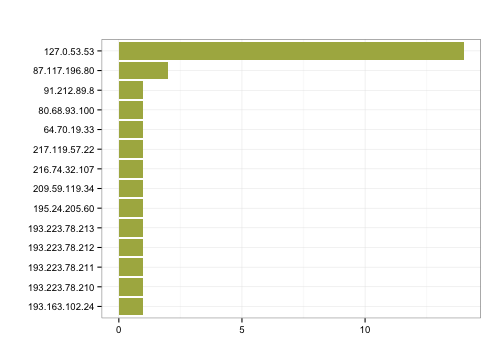By Bob Rudis (@hrbrmstr)
Fri 29 August 2014
|
tags:
dns,
tlds,
dplyr,
r,
rstats,
-- (permalink)
I saw this on Hacker News this morning and it got me curious as to how many other TLDs (e.g. .com) resolve to an address (i.e. https://uz./ displays a page in your browser since uz. resolves to 91.212.89.8). This is quick work with R and the resolv & iptools packages, plus I threw in a little dplyr for good measure:
library(iptools)
library(resolv)
library(dplyr)
library(ggplot2)
data(ianarootzonetlds) # iptools has IANA TLDs data built in
# iterate over the TLDs; try an A lookup getting NA back if bad
# could have used A() but originally intended to do more with the data
whichresolve <- sapply(ianarootzonetlds$Domain, function(x) {
y <- resolv_a(sprintf("%s.", gsub(".", "", x, fixed=TRUE)))
if (length(y) > 0) { y } else { NA }
})
tlds <- data.frame(ianarootzonetlds$Domain, whichresolve)
rownames(tlds) <- NULL
# which ones weren't NA == they have an IP address
# dplyr lets us use "pipes" (similar to unix pipes)
# to pass data around and it's far more readable than
# sticking conditionals in tons of nested brackets
tlds %>% filter(!is.na(whichresolve))
## ianarootzonetlds.Domain whichresolve
## 1 .ac 193.223.78.210
## 2 .active 127.0.53.53
## 3 .ai 209.59.119.34
## 4 .autos 127.0.53.53
## 5 .bmw 127.0.53.53
## 6 .cm 195.24.205.60
## 7 .dk 193.163.102.24
## 8 .gg 87.117.196.80
## 9 .green 127.0.53.53
## 10 .homes 127.0.53.53
## 11 .io 193.223.78.212
## 12 .je 87.117.196.80
## 13 .lgbt 127.0.53.53
## 14 .lotto 127.0.53.53
## 15 .meet 127.0.53.53
## 16 .mini 127.0.53.53
## 17 .motorcycles 127.0.53.53
## 18 .ngo 127.0.53.53
## 19 .nra 127.0.53.53
## 20 .pn 80.68.93.100
## 21 .sh 193.223.78.211
## 22 .spiegel 127.0.53.53
## 23 .tk 217.119.57.22
## 24 .tm 193.223.78.213
## 25 .to 216.74.32.107
## 26 .uz 91.212.89.8
## 27 .ws 64.70.19.33
## 28 .yachts 127.0.53.53
# since we can eyeball one very common IP address, see how common it is
# and use a fairly common dplyr chain to get the results
tlds %>%
filter(!is.na(whichresolve)) %>% # exclude some
group_by(whichresolve) %>% # group by IP
tally() %>% # get a count
select(IP=whichresolve, n) %>% # rename & select columns
arrange(desc(n)) # sort
## IP n
## 1 127.0.53.53 14
## 2 87.117.196.80 2
## 3 193.163.102.24 1
## 4 193.223.78.210 1
## 5 193.223.78.211 1
## 6 193.223.78.212 1
## 7 193.223.78.213 1
## 8 195.24.205.60 1
## 9 209.59.119.34 1
## 10 216.74.32.107 1
## 11 217.119.57.22 1
## 12 64.70.19.33 1
## 13 80.68.93.100 1
## 14 91.212.89.8 1
and use the dplyr chain directly with ggplot2 (and using Pantone’s “color of the day” for August 29th, 2014 for fun):
tlds %>%
filter(!is.na(whichresolve)) %>%
group_by(whichresolve) %>%
tally() %>%
select(IP=whichresolve, n) %>% # magrittr/dplyr pipe works nicely with ggplot
ggplot(aes(x=reorder(IP, n), y=n)) +
geom_bar(stat="identity", fill="#ACB350") +
coord_flip() + labs(x="", y="", title="") + theme_bw()

Out of 679 entries in the IANA TLDs, 28 resolve and, of those, 14 to the same IP address, which just happens to be the new “Name Collission” IP address. Excluding that address, there are just 13 unique IP addresses and only 14 domains that have an actual IPv4 address. For fun, we can see where those IPs “live”:
# using tbl_df() to make the output more compact
# feeding a "dplyr chained" column right into iptools' geoip()
# which is probably making Jay cringe right about now
tbl_df(geoip((tlds %>%
filter(!is.na(whichresolve) & whichresolve != "127.0.53.53") %>%
select(IP=whichresolve))$IP))
## Source: local data frame [14 x 13]
##
## ip country.code country.code3 country.name region region.name city
## 1 193.223.78.210 GB GBR United Kingdom NA NA NA
## 2 209.59.119.34 AI AIA Anguilla 00 NA The Valley
## 3 195.24.205.60 CM CMR Cameroon NA NA NA
## 4 193.163.102.24 DK DNK Denmark NA NA NA
## 5 87.117.196.80 GB GBR United Kingdom NA NA NA
## 6 193.223.78.212 GB GBR United Kingdom NA NA NA
## 7 87.117.196.80 GB GBR United Kingdom NA NA NA
## 8 80.68.93.100 GB GBR United Kingdom NA NA NA
## 9 193.223.78.211 GB GBR United Kingdom NA NA NA
## 10 217.119.57.22 DE DEU Germany NA NA NA
## 11 193.223.78.213 GB GBR United Kingdom NA NA NA
## 12 216.74.32.107 US USA United States CA California Richmond
## 13 91.212.89.8 UZ UZB Uzbekistan NA NA NA
## 14 64.70.19.33 US USA United States MO Missouri Chesterfield
## Variables not shown: postal.code (fctr), latitude (dbl), longitude (dbl), time.zone (fctr),
## metro.code (int), area.code (int)
While the post did want to answer a certain question, one of the main goals was to give a sneaky introduction to working with dplyr. It’s a powerful new idiom in R that helps make code more logical, readable and (in most cases) much faster. A good place to learn more is over at the official introduction vignette.
